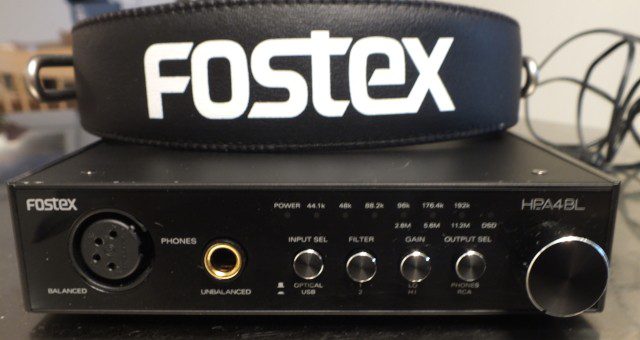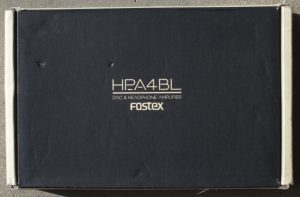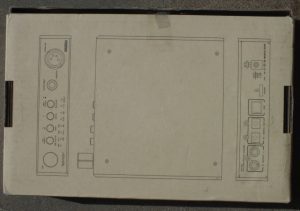
Fostex HP-A4BL DAC/AMP
I recently got to try out the Fostex HP-A4BL dac/amp as part of the Dekoni Blue review tour. Dekoni wisely had decided to send this unit with the Blue as the T50rp drivers are known for being a power sponge and it seemed wise to make sure that reviewers had an amplifier that was up to the task. I’ll admit that since I have a Burson Fun, I didn’t use the little Fostex for most of my testing of the Blue, but my curiosity got the best of me and this review is the result.
Packaging / Accessories:
The box is unassuming enough but well padded with a separate compartment for the power supply and enough foam to protect the main unit from bumps and bangs in transit. I particularly liked the use of the bottom of the box as a way to show all the controls although for those who generally pitch the box this may be less than helpful. The accessories are utilitarian enough a simple power adapter and USB cable are provided.


Build Quality:
The unit feels light but still feels well made. All the seams are well fitted with no gaps or mis-alignments. Buttons are all well-centered in the cuts for them as were the LEDs. Controls are all very positive and gave tactile feedback to let you know they have been set. Overall, a well made unit.
Inputs:
The USB and Optical inputs are on the rear of the unit as shown below. The USB supports USB 2.0 and supports 16 or 24 bit quantization with sampling rates from 44.1 to 192kHz for PCM and 2.8(64), 5.6(128), and 11.2mHz(512) DSD when the Fostex drivers are loaded. The Optical input gives the same bit rate choices for PCM but does not have the DSD support. The other input on the back panel is something that seems exciting but actually isn’t. Unfortunately ,the micro-sd slot is only for firmware updates and cannot be used for music playback directly from a card. For those that need to update the firmware, you will need a blank 32gb or smaller micro-sd card formatted with fat32. The firmware has to be copied to the root of the card, then the card installed into the unit before powering it on. I know, I got excited too when I first saw it and thought it was a playback device, sorry to disappoint.

Outputs:
Outputs are split between the rear (RCA and Optical) shown above, and the front (6.3mm and 4-pin XLR Balanced). I used the device both as a DAC paired to the Burson Fun as the Amp and as a stand alone via both the 6.3 and the XLR connections. I did not test the Optical output as I didn’t have an amp with an optical input handy. The 6.3mm output had no problem driving the Dekoni Blue while the XLR doubles the output power and was more than enough to handle even my 600Ω Beyers. I did find the noise floor to be slightly high for use with IEMs as a perceptible hiss is present when using my Eartech Quints or Magaosi K5s, but when you move to slightly less sensitive or higher impedance models like the Campfire Comet the hiss disappears. this phenomenon is not wholly surprising considering the target audience for this device is quite obviously Fostex planars.

Controls:
From left to right, the front panel has the XLR connector, the 6.3mm Jack, the input selection button, the filter button, the Gain Switch, the output selection switch, and finally the volume control. Input selection allows switching between USB and toslink. Filter is either sharp(1) or slow(2) roll-off when using PCM or high cut-off frequency(1) or low cut-off frequency(2) when using DSD. Gain is a 2 position switch with the high gain position offering a 10dB boost over the low. The output selector lets you enable either the headphone jacks or the RCA outputs. The Toslink output seems to be enabled only when RCA is selected as well although the control is not marked as such. Above the controls are a series of LEDs that show the frequency during playback with both PCM and DSD options shown. The Sole control on the rear face is the auto-standby mode switch which allows for dropping the unit into a low power state when not in use. the downside is that some PCs will lose the unit when it drops into this state and require powering the unit off and back on to find it again (Windows 10 particularly). If using USB input, it may be advisable to leave the power saving turned off.
Sound Quality:
This is always the toughest part of the review of a DAC/amp for two reasons. First, if the device is doing its job, it shouldn’t be contributing to the overall signature and second, if it is contributing to the signature which component is responsible for that contribution. The HP-A4BL has a near neutral signature with perhaps just a shade of lower treble enhancement. The unit had good detail retrieval and better than average dynamics which is quite a feat when using 600Ω headphones. I found no major areas of coloration of the sound when using the unit either as just a DAC or when using both the DAC and amp sections. Power was more than adequate for all the headphones I tried and more than needed for the vast majority of them. Using the single ended output with the Dekoni Blue, I had the volume knob at roughly 11 oclock on high gain and that was as high as I could go and tolerate it. With the 600Ω Beyers, I was able to use the XLR output and managed to get to about 2pm on the dial before the level was sufficient to make me back it down. In both cases a sustained listening levels would have been a couple hours before the listed positions on the dial.
Conclusions:
While not an inexpensive unit, the HP-A4BL certainly checks in at a reasonable price point but one with pretty stiff competition. I had on the bench at the time of writing this, an iFi Micro BL, a Schiit Jotenhiem, and the Burson Play all of which fit the same bill. Some (ifi) offer portability, others (Schitt) offer modularity, still others (Burson) offer your choice of op-amps to tailor the sound to your liking, and yet with all these other options, the HP-A4BL manages to carve out a niche for itself. For those who appreciate a simple device that does what they need without the need to fiddle with it or fight with drivers incessantly, the little Fostex has a lot to like. If you are in the market for a DAC/Amp combo, this little unit should be on your list to audition. Matter of fact, if you put it first on your list, you may be able to stop after #1.







